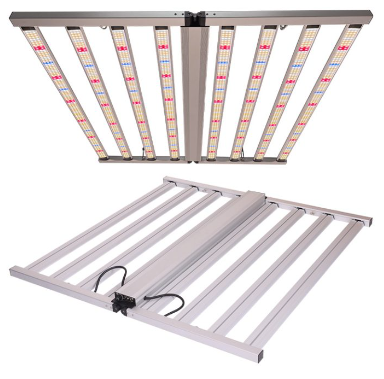Strawberries are beloved worldwide, but cultivating them successfully in a greenhouse requires a keen understanding of the environment and plant needs. In this comprehensive guide, we’ll walk you through the essential steps and best practices for growing strawberries in a greenhouse, including the critical role that LED grow lights play in ensuring your plants thrive year-round.
Why Choose Greenhouses for Growing Strawberries?

While greenhouses offer many advantages, one challenge they present is the lack of natural pollinators, such as bumblebees. Pollination is critical for strawberries, so understanding how to manage this process in a greenhouse is key to a successful harvest.
Choosing the Right Strawberry Varieties for Your Greenhouse
Not all strawberry varieties are suited for greenhouse environments. For optimal results, you should choose varieties that thrive in controlled settings.
- Day-neutral strawberries: These are the best choice for greenhouses as they yield fruit throughout most of the growing season. Their ability to produce fruit consistently makes them perfect for year-round cultivation.
- June-bearing strawberries: These produce a concentrated harvest in early summer, making them ideal for hanging baskets in greenhouses. However, they do not offer the same consistent yield as day-neutral varieties.
Planting Strawberries in Your Greenhouse: When and How?
Strawberries can be planted in a greenhouse throughout the year, but fall planting is particularly popular. Planting in the fall allows strawberries to bloom in winter, producing fruit that can be harvested through the spring. This method provides a continuous supply of fresh strawberries.
However, the timing of planting can vary depending on the type of strawberry you’re growing and the specific climate conditions inside your greenhouse. Greenhouse cultivation gives you the flexibility to grow strawberries regardless of outdoor weather conditions.
Key Growing Conditions for Strawberries in Greenhouses
To ensure your strawberries thrive in the controlled environment of a greenhouse, you need to maintain optimal conditions for lighting, soil, watering, temperature, and humidity. Here’s a breakdown of the critical factors:
Lighting Requirements: Use LED Grow Lights for Maximum Yield
Strawberries require at least 6 hours of sunlight per day, but in a greenhouse, natural light might not be enough, especially during the winter months. This is where LED grow lights come into play. Full-spectrum LED grow lights simulate natural sunlight and provide the necessary light for photosynthesis, ensuring your strawberry plants grow vigorously throughout the year.
For best results, your strawberries should receive 12 hours of light during the growing season. Using adjustable LED grow lights allows you to fine-tune the light exposure and optimize plant growth at different stages.
Soil: Create the Perfect Foundation for Your Plants
Strawberries prefer slightly acidic soil with a pH level between 5.5 and 6.5. Too high or too low of a pH can lead to nutrient deficiencies, affecting plant health and fruit production. Additionally, strawberries need deep, fertile, and well-drained soil rich in organic matter to produce the best yields.
Consider using raised beds or containers in the greenhouse to provide excellent drainage and prevent waterlogging, which can lead to root rot.
Watering: Finding the Right Balance
Watering strawberries in a greenhouse requires careful attention. The soil should be kept damp but not soggy. Overwatering can weaken the plants and lead to issues like berry rot. Drip irrigation systems are an efficient solution, as they provide consistent moisture directly to the plant roots, reducing the risk of waterlogging.
 Humidity: Control Is Key
Humidity: Control Is Key
Humidity in a greenhouse can fluctuate dramatically, and this can affect strawberry plants. High humidity can lead to poor transpiration, while low humidity can cause water loss and even tip burns on the leaves. The optimal relative humidity for strawberries during flowering and fruiting is between 65% and 75%.
Proper ventilation is essential to regulate humidity levels. Fans and airflow systems can help maintain an ideal environment for your plants to thrive.
Temperature: Keep It Just Right
Temperature management is one of the most critical aspects of greenhouse strawberry cultivation. Strawberries perform best when the temperature is 16°C during the day and 8°C at night. As the plants grow, you can gradually increase the temperature to 20-24°C during the day and 10-12°C at night.
During the flowering stage, maintaining a temperature range of 16-20°C is ideal, while during fruiting, temperatures between 15-16°C will help your strawberries ripen perfectly.
Pollination in Greenhouses: Ensuring a Successful Harvest
Although strawberries are self-pollinating, they still require adequate pollination to ensure fruit development. In nature, wind and insects facilitate this process, but in a greenhouse, it’s essential to create airflow for pollen transfer. You can also use a small brush to manually pollinate flowers if necessary.
Common Pests and Diseases: How to Protect Your Strawberries
While greenhouses keep many pests out, strawberries are still susceptible to a few issues, such as:
- Gray mold: Caused by high humidity, it can be managed by improving ventilation and spacing between plants.
- Powdery mildew: Often a result of high humidity, it can be reduced by keeping temperatures in check and maintaining good airflow.
- Root weevils: These pests can damage the roots and hinder plant growth. Biological control methods can be effective in managing this problem.
Should You Rotate Your Strawberry Crops?
It’s essential to rotate your strawberry crops every few years. After about 3 years, strawberry plants begin to lose vigor and are more prone to diseases. Rotating crops helps reduce the buildup of pests and ensures better yields when planting new strawberry plants.
Final Thoughts: Grow Strawberries Year-Round with the Right Tools
Growing strawberries in a greenhouse is an excellent way to enjoy fresh fruit all year long, but to do so successfully, you need the right tools and environment. Proper lighting, temperature control, humidity management, and soil care are all essential, and LED grow lights are an indispensable part of ensuring your plants receive the necessary light year-round.
At Shenzhen Andy Photoelectric Technology Co., Ltd., we specialize in providing high-quality LED grow lights designed to meet the unique needs of strawberry cultivation. Contact us today to learn more about how our products can help you grow healthy, thriving strawberries in your greenhouse!































